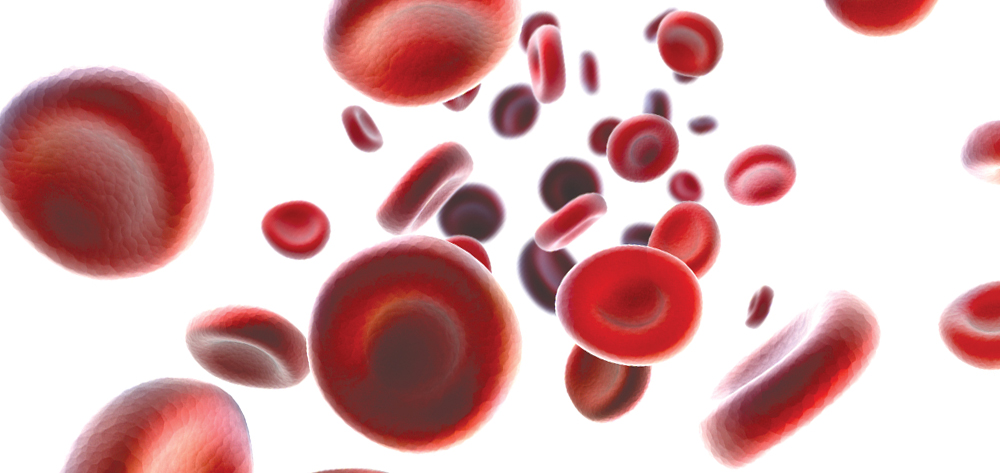Editor’s note: One of a series of articles on managing cancer-related symptoms from the Oncology Nursing Society.
A complex assortment of disease- and treatment-related factors can contribute to bleeding in patients with cancer. A reduction in quantity or functionality of platelets, an alteration in clotting factors, paraneoplastic syndrome, or a combination of these factors all can lead to bleeding (Damron & Samsonow, 2009). Ongoing bleeding can hinder patients’ quality of life by elevating fatigue and weakness levels, and bleeding with hemorrhage can even become life-threatening. In addition, bleeding can lead to increased distress for patients and caregivers.
Patients suffering from certain malignancies, such as acute promyelocytic leukemia (APL), have a higher chance of bleeding (up to 90% of patients with APL will have a hemorrhagic complication) (DeSancho & Rand, 2001). Mucin-producing adenocarcinomas have a high probability of bleeding as well. Other causes, such as thrombocytopenia, may develop from chemotherapy or radiation therapy (Damron & Samsonow, 2009). Infection, disseminated intravascular coagulation, liver disease, and platelet dysfunction all are issues too (Kwaan & Vicuna, 2007).
Before starting any treatment for patients with cancer, particularly those at high risk for bleeding, nurses should assess patients for risk factors (Table 1). Nurses are in a unique position to review this information and work with the healthcare team to prevent bleeding in patients with cancer.
Table 1. Risk factors for bleeding in patients with cancerPatient History
Physical Assessment
Based on information from Friend & Pruett, 2004. |
Putting evidence into practice
To promote nursing practice that is based on evidence, ONS launched the Putting Evidence Into Practice (PEP) program in 2005. ONS PEP teams consisting of advanced practice nurses, staff nurses, and a nurse scientist were charged with reviewing the literature to determine what treatments and interventions are proven to alleviate many cancer-related problems that are sensitive to nursing interventions. Each team classified interventions under the following categories: recommended for practice, likely to be effective, benefits balanced with harms, effectiveness not established, effectiveness unlikely, and not recommended for practice.
Recommended for practice
The use of platelet threshold maintenance, platelet transfusions to control active bleeding, and mesna for the prevention of hemorrhagic cystitis are recommended for practice based on effectiveness established through rigorously designed studies, meta-analysis, systemic reviews, or professional guidelines. (Damron & Samsonow, 2009).
Platelet threshold maintenance: Nurses must assess each patient individually and base platelet threshold on risk of hemorrhage and symptoms such as fever, a rapidly declining platelet rate, and coagulation abnormalities (Damron & Samsonow, 2009). However, general guidelines for platelet threshold, based on information from Callow, Swindell, Randall, and Chopra (2002), Heddle et al. (2006), and Stanworth et al. (2004), are:
- Maintain platelet threshold at 10×103/microliter for the majority of patients
- Maintain platelet threshold at 20×103/microliter for patients undergoing minor procedures and those with certain tumors (e.g., bladder, necrotic, highly vascular forms).
- Maintain prophylactic threshold at 40×103/microliter -50×103/microliter for patients undergoing invasive procedures.
Platelet transfusions to control active bleeding: For patients who are actively bleeding, the healthcare team should consider platelet transfusions based on information from Callow et al. (2002), Heddle et al. (2006), Schiffer et al. (2001), and Stanworth et al. (2004).
Mesna for the prevention of hemorrhagic cystitis: Mesna may be combined with ifosfamide to decrease urothelial toxicity associated with ifosfamide treatment. The following recommendations from the American Society of Clinical Oncology (Schuchter, Hensley, Meropol, and Winer, 2002) support mesna use.
- For ifosfamide doses of less than 2.5 g/m2 per day, administered as short infusion, IV mesna is recommended at 60% of the ifosfamide dose and should be given 15 minutes before chemotherapy and four and eight hours after each ifosfamide dose.
- For continuous infusion ifosfamide, mesna should be given as a bolus dose (20%) prior to chemotherapy and continued at 40% of the ifosfamide dose 12-24 hours following ifosfamide treatment.
- Oral mesna may be used as a substitute for the second and third doses of IV mesna when ifosfamide dosage is less than 2 g/m2 per day (Mace et al., 2003).
In addition, mesna plus saline diuresis (or forced saline dieresis) often is used with cyclophosphamide administration in patients undergoing stem cell transplantations (Schuchter et al., 2002). Insufficient evidence exists to recommend a specific mesna dose when high-dose ifosfamide exceeds 2.5 g/m2 per day; however, more frequent or prolonged dosing of mesna may be necessary to achieve urothelial protection (Schuchter et al., 2002).
Effectiveness not established
Insufficient or conflicting data or data of inadequate quality exist for the information presented in this category.
Prohemostatic agents have been studied in small case series reports or single-arm trials. Under this category, desmopressin, epsilon amino-caproic acid (EACA) together with tranexamic acid (TA), and TA alone all showed some potential benefit for bleeding prevention or reduction. At the same time, studies examining EACA alone produced mixed results (Damron & Samsonow, 2009). Recombinant interleukin-11 also has shown some promise as a platelet growth factor. Results from Isaacs et al. (1997), Teplar et al. (1996), and Tsimberidou et al. (2005) show increased platelet production, decreased need for platelet transfusions, higher platelet nadirs, and a shorter median time for platelets to reach a threshold of more than 100,000.
Other possible interventions listed as effectiveness not established include common menstrual bleeding measures, recombinant epidermal growth hormone for urothelial protection, tetrachlorodecaoxygen anion complex IV solution for radiation-induced hemorrhagic cystitis and/or proctitis, endoscopic procedures to attenuate bleeding, and ultrasonic-activated surgical instruments for endovascular embolization procedures (Damron & Samsonow, 2009).
Sean Pieszak is a copy editor in the publishing division at the Oncology Nursing Society in Pittsburgh, PA. More information about the ONS PEP classification for the prevention of bleeding can be found at http://www.ons.org/Research/PEP/Bleeding.
References
Callow, C.R., Swindell, R., Randall, W., & Chopra, R. (2002). The frequency of bleeding complications in patients with haematological malignancy following the introduction of a stringent prophylactic platelet transfusion policy. British Journal of Haematology, 118, 667-682. doi:10.1046/j.1365-2141.2002.03616.x
Damron, B.I., & Samsonow, S.M. (2009). Prevention of bleeding. In L.H. Eaton and J.M. Tipton (Eds.), Putting Evidence Into Practice: Improving oncology patient outcomes (pp. 253-265). Pittsburgh, PA: Oncology Nursing Society.
DeSancho, M.T., & Rand, J.H. (2001). Bleeding and thrombotic complications in critically ill patients with cancer. Critical Care Clinics, 17, 599-622. doi:10.1016/S0749-0704(05)70200-1
Friend, P.H., & Pruett, J. (2004). Bleeding and thrombotic complications. In C.H. Yarbro, M.H. Frogge, & M. Goodman (Eds.), Cancer symptom management (3rd ed., pp 233-251). Sudbury, MA: Jones and Bartlett.
Heddle, N.M., Cook, R.J., Sigouin, C., Slichter, S.J., Murphy, M., & Rebulla, P. (2006). A descriptive analysis of international transfusion practice and bleeding outcomes in patients with acute leukemia. Transfusion, 46, 903-911. doi:10.1111/j.1537-2995.2006.00822.x
Isaacs, C., Robert, N.J., Bailey, F.A., Schuster, M.W., Overmoyer, B., Graham, M., Kaye, J.A. (1997). Randomized placebo-controlled study of recombinant human interleukin-11 to prevent chemotherapy-induced thrombocytopenia in patients with breast cancer receiving dose-intensive cyclophosphamide and doxorubicin. Journal of Clinical Oncology, 15, 3368-3377.
Kwaan, H.C., & Vicuna, B. (2007). Thrombosis and bleeding in cancer patients. Oncology Reviews, 1, 14-27. doi:10.1007/s12156-007-0003-7
Mace, J.R., Keohan, M.L., Bernardy, H., Junge, K., Niebch, G., Romeis, P., Baker, L.H. (2003). Crossover randomized comparison of intravenous versus intravenous/oral mesna in soft tissue sarcoma treated with high-dose ifosfamide. Clinical Cancer Research, 9(16, Pt. 1), 5829-5834.
Schiffer, C.A., Anderson, K.C., Bennett, C.L., Bernstein, S., Elting, L.S., Goldsmith, M., Wagnon, A.H. (2001). Platelet transfusion for patients with cancer: Clinical practice guidelines of the American Society of Clinical Oncology. Journal of Clinical Oncology, 19, 1519-1538.
Schuchter, L.M., Hensley, M.L., Meropol, N.J., & Winer, E.P. (2002). 2002 update of recommendations for the use of chemotherapy and radiotherapy protectants: Clinical practice guidelines of the American Society of Clinical Oncology. Journal of Clinical Oncology, 20, 2895-2903. doi:10.1200/JCO.2002.04.178
Stanworth, S.J., Hyde, C., Heddle, N., Rebulla, P., Brunskill, S., & Murphy, M.F. (2004). Prophylactic platelet transfusion for haemorrhage after chemotherapy and stem cell transplantation. Cochrane Database of Systematic Reviews, 4, CD004269. doi:10.1002/14651858.CD004269.pub2
Teplar, I., Elias, L., Smith, J.W., Hussein, M., Rosen, G., Chang, Y., Kaye, J.A. (1996). A randomized placebo-controlled trial of recombinant human interleukin-11 in cancer patients with severe thrombocytopenia due to chemotherapy. Blood, 87, 3607-3614.
Tsimberidou, A.M., Giles, F.J., Khouri, I., Bueso-Ramos, C. Pilat, S., Thomas, D.A., Kurzrock, R. (2005). Low-dose interleukin-11 in patients with bone marrow failure: Update of the MD Anderson Cancer Center experience. Annals of Oncology, 16, 139-145. doi:10.1093/annonc/mdi007


















